| July 2014 | ||
 Print Print  Email Email |
Archive | |

| www.ibew.org |
|
 |
|

|

NASA is betting nearly $8 billion on the skill and competence of nearly 250 members of Baltimore Local 1501, the engineers and technicians working on the James Webb Space Telescope at the Goddard Space Flight Center. The Webb telescope is one of NASA's largest, most expensive missions ever, the successor to the path-breaking Hubble Telescope. Components for the telescope have been under construction in 27 states and 14 countries for nearly a decade, but in recent months, many of those components have come to Goddard, and assembly for the October 2018 launch has begun. Using an array of infrared sensors and a mirror nearly six times larger than Hubble's, the Webb telescope is designed to find and study the oldest, farthest, faintest objects in the universe to answer some of the most basic questions about how stars ignited, galaxies formed and planets coalesced out of the echo of the Big Bang. "Its purpose is to address the deepest questions we have: Where did we come from? Are we alone?" said Amber Straughn, deputy project scientist at Goddard. But for the telescope's four sensors to see into the early life of the universe, they will need to be cooled to only a few degrees above absolute zero, which is only possible far away from the heat emitted by the sun, the Earth or even the moon. Hubble orbits 375 miles up; the Webb telescope will be sent more than 1 million miles away, four times farther than the moon. So far that if anything goes wrong, if something on the telescope breaks, doesn't line up or unfold correctly, if none of the systems on board can fix it, no rescue or repair mission will be possible. |

|
© Copyright 2014 International Brotherhood of Electrical Workers | User Agreement and Privacy Policy | Rights and Permissions |